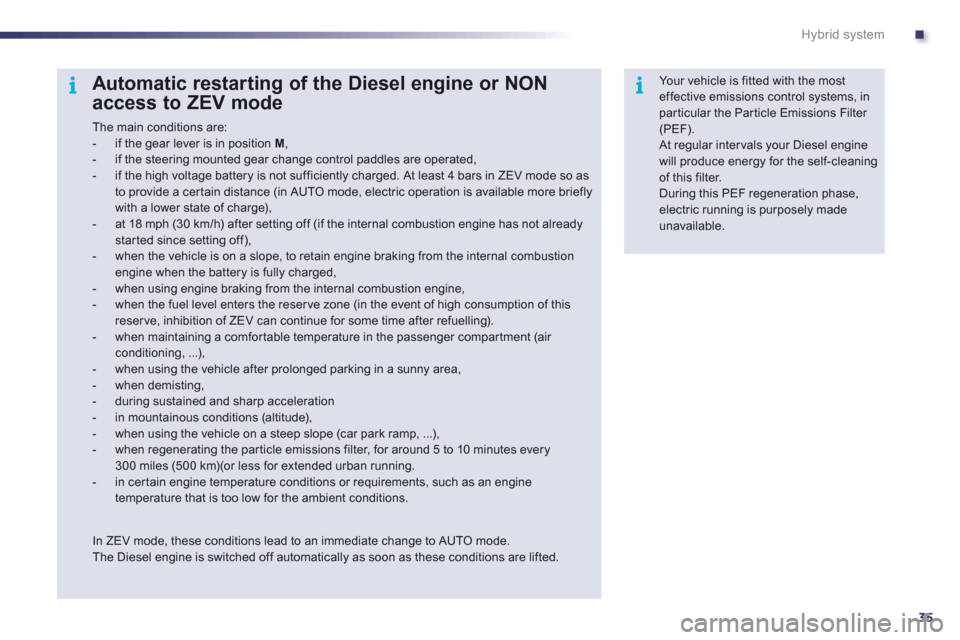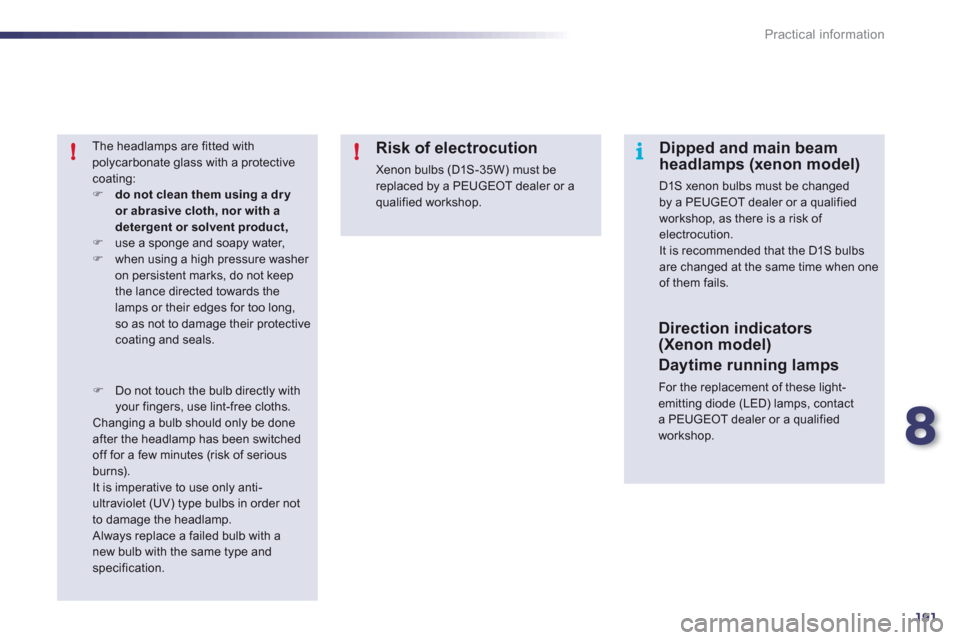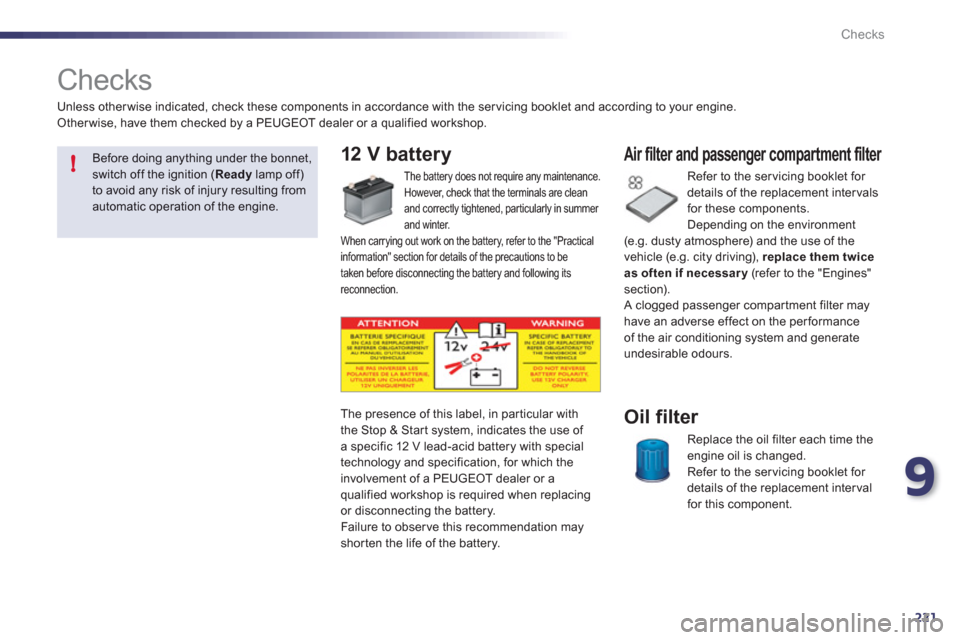change time Peugeot 508 RXH 2012 Owner's Manual
[x] Cancel search | Manufacturer: PEUGEOT, Model Year: 2012, Model line: 508 RXH, Model: Peugeot 508 RXH 2012Pages: 302, PDF Size: 9.33 MB
Page 37 of 302

.
35
ii
Hybrid system
Automatic restarting of the Diesel engine or NON
access to ZEV mode
The main conditions are:
- if the gear lever is in position M,
- if the steering mounted gear change control paddles are operated,
- if the high voltage battery is not sufficiently charged. At least 4 bars in ZEV mode so asto provide a cer tain distance (in AUTO mode, electric operation is available more brieflywith a lower state of charge),
- at 18 mph (30 km/h) after setting off (if the internal combustion engine has not alreadystar ted since setting off),
- when the vehicle is on a slope, to retain engine braking from the internal combustion engine when the battery is fully charged,
- when using engine braking from the internal combustion engine,
- when the fuel level enters the reser ve zone (in the event of high consumption of thisreser ve, inhibition of ZEV can continue for some time after refuelling).
- when maintaining a comfor table temperature in the passenger compar tment (air conditioning, ...),
- when using the vehicle after prolonged parking in a sunny area,
- when demisting,
- during sustained and sharp acceleration
- in mountainous conditions (altitude),
- when using the vehicle on a steep slope (car park ramp, ...),
- when regenerating the par ticle emissions filter, for around 5 to 10 minutes every300 miles (500 km)(or less for extended urban running.
- in cer tain engine temperature conditions or requirements, such as an enginetemperature that is too low for the ambient conditions.
In ZEV mode, these conditions lead to an immediate change to AUTO mode. The Diesel engine is switched off automatically as soon as these conditions are lifted.
Your vehicle is fitted with the most effective emissions control systems, inparticular the Particle Emissions Filter (PEF).
At regular intervals your Diesel engine will produce energy for the self-cleaningof this filter.
During this PEF regeneration phase,electric running is purposely madeunavailable.
Page 39 of 302

.
37
Hybrid system
Eco-driving
Eco-driving is a range of everyday practices that allow the motorist to optimise their fuel consumption and CO2 emissions.
Optimise the use of your
gearbox
Use automatic mode Aas much as possible as this optimises gear changes to suit the
circumstances.
Drive smoothly
Maintain a safe distance between vehicles, use engine braking rather than the brake pedal, and press the accelerator progressively. These practices contribute towards a reduction in fuel consumption and CO2 emissions and also helps reduce thebackground traffic noise.
If your vehicle has cruise control, make use of the system at speeds above 25 mph (40 km/h) when the traffic is flowing well.
Control the use of your
electrical equipment
Before moving off, if the passenger compartment is too warm, ventilate it byopening the windows and air vents before using the air conditioning.
Above 30 mph (50 km/h), close the windowsand leave the air vents open. Remember to make use of equipment that canhelp keep the temperature in the passenger compartment down (sun roof and window blinds...).Switch off the air conditioning, unless it has automatic digital regulation, as soon as the desired temperature is attained.Switch off the demisting and defrosting controls, if not automatic.
Switch off the heated seat as soon as possible.
Switch off the headlamps and front foglampswhen the level of light does not require their use.
Avoid running the Diesel engine when stationary, par ticularly in winter; your vehiclewill warm up much faster while driving.
As a passenger, if you avoid connecting your multimedia devices (film, music, video game...), you will contribute towards limitingthe consumption of electrical energy, and soof fuel.
Disconnect your por table devices beforeleaving the vehicle.
Page 149 of 302

5
147
i
i
Visibility
Adaptive lighting
Switching on
The driver can take over at any time, if the circumstances dictate:
System which automatically changes betweendipped and main beam according to the driving conditions, using a sensor in the rear viewmirror.
The system is active from 15 mph (25 km/h)
and is deactivated below 9 mph (15 km / h).
�)put the lighting control stalk on the "AUTO"
or "Dipped/main beam headlamps"
position,
Switching off
�) or by dipping the headlamps manually using the lighting control stalk, whether
in the "AUTO" or "Dipped/main beam
headlamps" position.
Flashing the headlamps does notdeactivate the system.The state of the system is stored in memory when switching off the ignition. This automatic headlamp dipping system is a driving aid. The driver remains responsible for the vehicle'slighting and its correct use for theprevailing conditions of light, visibility and traffic.
The system may suffer interference or not work correctly:
- under conditions of poor visibility(for example, snowfall, heavy rainor thick fog, ...),
- if the windscreen is dir ty, misted or obscured (by a sticker, ...) in front of the sensor,
- if the vehicle is facing highly reflective signs.
The system is not able to detect:
- road users that do not have their own lighting, such as pedestrians,
- road users whose lighting is obscured, such as vehicles running behind a safety barrier (on amotorway, for example),
- road users at the top or bottom of a steep slope, on twisty roads, on crossroads.
�)press this button, the
warning lamp goes off,
�) press this button, the
warning lamp comes on.
Page 193 of 302

8
191
!!i
Practical information
The headlamps are fitted with
polycarbonate glass with a protectivecoating:�)do not clean them using a dry or abrasive cloth, nor with a detergent or solvent product,�)
use a sponge and soapy water, �)
when using a high pressure washer on persistent marks, do not keep the lance directed towards thelamps or their edges for too long, so as not to damage their protectivecoating and seals.
Risk of electrocution
Xenon bulbs (D1S-35W) must bereplaced by a PEUGEOT dealer or aqualified workshop.
�)Do not touch the bulb directly withyour fingers, use lint-free cloths. Changing a bulb should only be doneafter the headlamp has been switched off for a few minutes (risk of serious burns). It is imperative to use only anti-ultraviolet (UV) type bulbs in order notto damage the headlamp. Always replace a failed bulb with a new bulb with the same type andspecification.
Dipped and main beamheadlamps (xenon model)
D1S xenon bulbs must be changedby a PEUGEOT dealer or a qualifiedworkshop, as there is a risk of electrocution.
It is recommended that the D1S bulbsare changed at the same time when oneof them fails.
Direction indicators (Xenon model)
Daytime running lamps
For the replacement of these light-emitting diode (LED) lamps, contacta PEUGEOT dealer or a qualified
workshop.
Page 223 of 302

9
221
!
Checks
Checks
12 V battery
The battery does not require any maintenance.
However, check that the terminals are clean
and correctly tightened, particularly in summer and winter.
When carrying out work on the battery, refer to the "Practical information" section for details of the precautions to be
taken before disconnecting the battery and following its reconnection.
Refer to the servicing booklet for
details of the replacement inter vals
for these components.
Dependin
g on the environment(e.g. dusty atmosphere) and the use of the
vehicle (e.g. city driving), replace them twiceas often if necessary (refer to the "Engines"section).
A clogged passenger compar tment filter mayhave an adverse effect on the per formanceof the air conditioning system and generate undesirable odours.
Air filter and passenger compartment filter
Replace the oil filter each time theengine oil is changed.
Refer to the servicing booklet for
details of the replacement inter val
for this component.
Oil filter The presence of this label, in particular with
the Stop & Star t system, indicates the use of a specific 12 V lead-acid battery with special
technology and specification, for which theinvolvement of a PEUGEOT dealer or a qualified workshop is required when replacing
or disconnecting the battery.Failure to obser ve this recommendation may
shor ten the life of the battery.
Unless other wise indicated, check these components in accordance with the ser vicing booklet and according to your engine.
Other wise, have them checked by a PEUGEOT dealer or a qualified workshop.
Before doing anything under the bonnet,switch off the ignition (Ready
lamp off) to avoid any risk of injury resulting fromautomatic operation of the engine.
Page 274 of 302

272
09
1
2
MUSIC MEDIA PLAYERS
CD, MP3 CD, USB PLAYER
Insert the CD in the player, insert the USB memorystick in the USB player or connect the USBperipheral to the USB port using a suitable cable (not supplied)
The system builds playlists (in temporary memory),
an operation which can take from a few seconds to several minutes at the fi rst connection.
R
educe the number of non-music fi les and the number of folders to reduce the waiting time.
The playlists are updated every time the ignition isswitched off or connection of a USB memory stick. However, the system memorises these lists and
if they are not modifi ed, the loading time will be shorter.
Pla
y starts automatically after a period which
depends on the capacity of the USB memory stick.
SELECTION OF SOURCE
The SOURCE or SRCbutton on the steering mounted controlsallows a direct change to the next media source.
"CD/CD MP
3"
"USB, iPod"
"AUX
" "STREAMING
" "RADIO
"
Pr
ess MEDIAto display the "MEDIA
"
menu.
Select "Change media" and confi rm.
Page 279 of 302

277
11
1
2
3a
3b
1
2
3
4
CONFIGURATION
Press SETUP
to display the"Confi guration " menu.
Select " Adjust luminosity" and confi rm
to adjust the screen brightness.
Pr
ess "OK" to save the changes.
The settin
gs for day and night areindependent.
Select " Choose colour" and confi rm torselect the screen colour harmony and
the map presentation mode:
-
day mode,
- n
ight mode,
- automatic day
/night mode,
according to whether the headlamps are on.
SETTING THE DATE AND TIME
Select "Set date and time
" and confi rm.
Select the settin
g to adjust.
Confi rm by pressing OK, then adjust
the setting and confi rm again to save
the modifi cation.
Select " Display confi guration" andconfi rm.
Press SETUPto display the
" Confi guration" menu.
Select "Display confi guration
" andconfi rm.
Adjust the settings one by one.
Then select " OK " on the screen and confi rm to save the settings.
DISPLAY CONFIGURATION
Select " Synchronize the minutes with GPS" so that setting theminutes is done automatically by satellite reception.